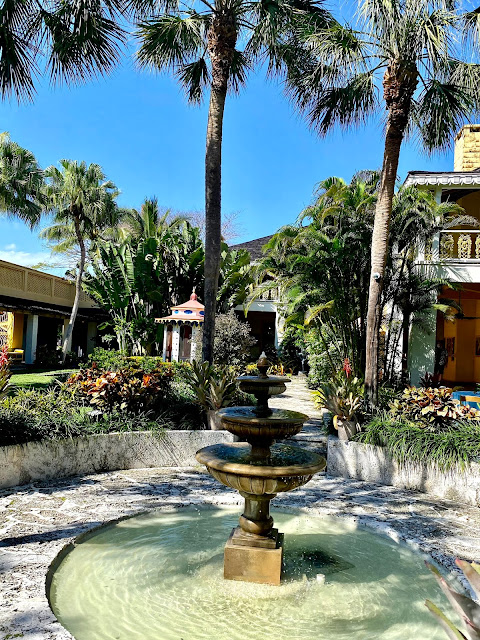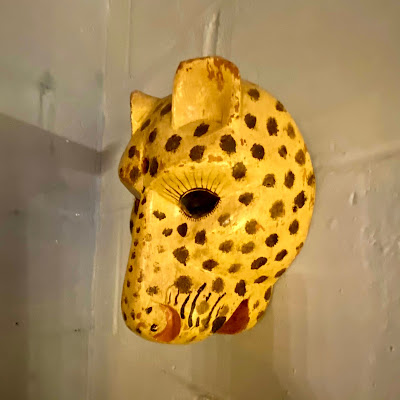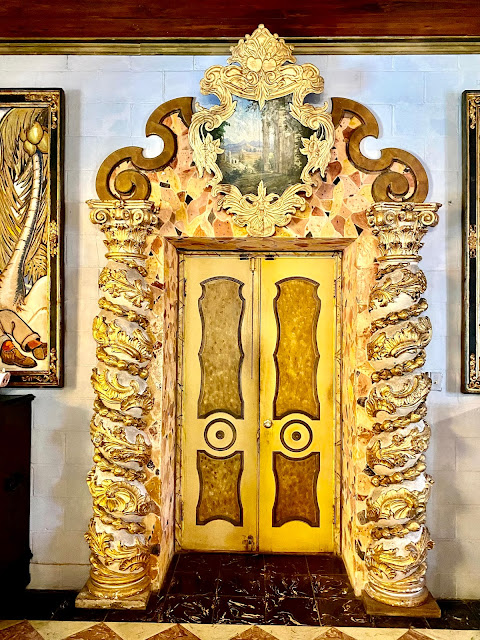It's called the Bonnet House because the owners pretended the alligators who lived on the property donned the lily pads in this water before hoisting themselves up on the veranda.
With a story like that, you've got to wonder how many Rang Pur lime cocktails Frederick Bartlett, his second wife, Helen Birch, and guests had imbibed beforehand. Entering the property requires crossing a wooden bridge. A boat house door betrays the sunny color scheme to come. Yellow is to Bonnet House what blue is to the Majorelle Jardin.
There's even a desert garden, just like in Marrakesh.
One thing's for sure, the Bartletts wintered extremely well in their unprepossessing compound, built in the "plantation" style.
Fred trained as an artist in Munich. But no garret for him after he married Helen whose parents gave the newlyweds beachfront property in Fort Lauderdale, much of which eventually became Hugh Taylor Birch State Park. Fred built his studio first, in 1919.
Fred worked primarily as a muralist but smaller canvases hang throughout the house as well.
Fred and Helen amassed an early collection of Impressionists, including George Seraut's "A Sunday Afternoon on the Island of La Grande Jatte," which they donated to the Art Institute of Chicago. After Helen died, leaving Fred a widow for the second time, he married Evelyn Fortune, an Indianapolis divorcee. She became an artist in her own right.
 |
| Evelyn Fortune, Self Portrait |
I prefer Evelyn's work, particularly her extraordinary sense of color.
 |
| Yellow Keys (detail) |
In their only collaboration, Fred and Evelyn painted this ceiling in the south loggia. He gave her the harder part of the job: the water and the netting.
Love this wooden statue.
But by and large, the Bartletts taste in home decor leaned towards kitsch. Not that there's anything wrong with that!
Evelyn outlived her husband by nearly half a century, dying just two months shy of her 110th birthday in 1997. She also had a thing for monkeys. Dozens swung from the trees of her estate which was valued at $35 million in 1983 when she bequeathed it to the state of Florida.
A video includes interviews with Evelyn and gives her a posthumous opportunity to emphasizes her critical role in decoration and preservation of the Bonnet House. It ignores what must have been interesting family dynamics after Fred's death. For example, Helen's music room remains intact while Evelyn's works are segregated in the building where we watched the video.
Nothing inside the house has changed since its glory days. Here's the butler's pantry.
Delft china, hand painted tiles, centaurs, beer steins and stuffed fish--not the edible kind--comprise the delirious dining room potpourri.
Fred's eye for architecture produced this trompe l'oeil corner.
Over-the-top is the only way to describe the drawing room.
Particularly this doorway.
The Bonnet House lacks Vizcaya's gorgeous grounds. But they were large enough to require a tractor. With a hand crank!






































No comments:
Post a Comment